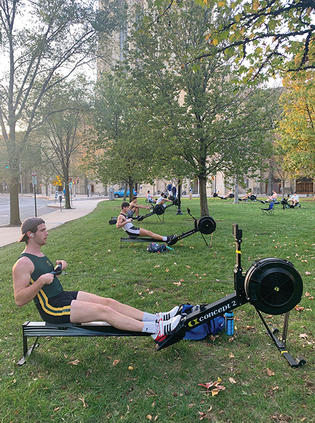
Mark Alden Branch ’86
James Casemore ’24 and his teammates on the lightweight crew moved their rowing machines outside for workouts in the fall.
View full image
During an uncertain summer for universities across the country, the Ivy League was among the first to provide some clarity. By early July, the conference definitively announced that no athletic competition would take place in the fall semester. On the Yale campus, as the effects of the pandemic continued to ripple across daily life, stadiums went silent and many student-athletes chose to take time off.
The Game had been set to take place at the restored Harvard Stadium, but it was canceled for the first time since 1944, when the reason was World War II. Most Yale upperclassmen on the team didn’t enroll in the fall, so they could retain eligibility to play in future years. Hannah Johns ’22, a member of the women’s rowing team and president of the Yale Student-Athlete Advisory Committee (SAAC), says that only 8 of over 40 members of her team were on campus in the fall. “The student-athlete community is fairly close. We all see each other in the gym, we all eat at the same times,” says Johns. “Not being around that is definitely different and definitely sad. The word I would use is ‘quiet.’”
To guide athletic activities for those who remained during the fall, the Ivy League developed a framework. The local conditions at each school would determine what types of physical activity could be allowed—from Phase 0, with no in-person gatherings at all, to “mid-size” practices at Phase III. Yale made it as far as Phase II in the beginning of October, which allowed two hours of practice each day in groups of up to ten. The interim phases led to unusual spectacles, like the socially distanced rowing machines that were dragged out onto the lawn of Payne Whitney Gymnasium.
With few student-athletes to look after, the football staff developed unique training plans for each player. “This is a period of time where we can focus on each player individually,” says head coach Tony Reno, now in his ninth year at the helm. “Most of our guys hadn’t been in a weight room since March. We’re making up for lost time.”
But in mid-October, just a few days after Yale had achieved Phase II, a COVID-19 outbreak that included 18 players on the men’s hockey team sent every Blue back to Phase 0. Limited conditioning resumed about two weeks later—only to return to Phase 0 when Yale moved to a university-wide “orange” alert level on November 6 as cases climbed across the country. Less than a week later, the Ivy League made its winter plans official: winter seasons were fully canceled, and any spring competition was postponed until at least the end of February. “When I decided to come back to campus in the fall, I knew it was going to be like this—this stop-start situation,” says Johns. “I think that expectation has been very helpful navigating it.”
 loading
loading